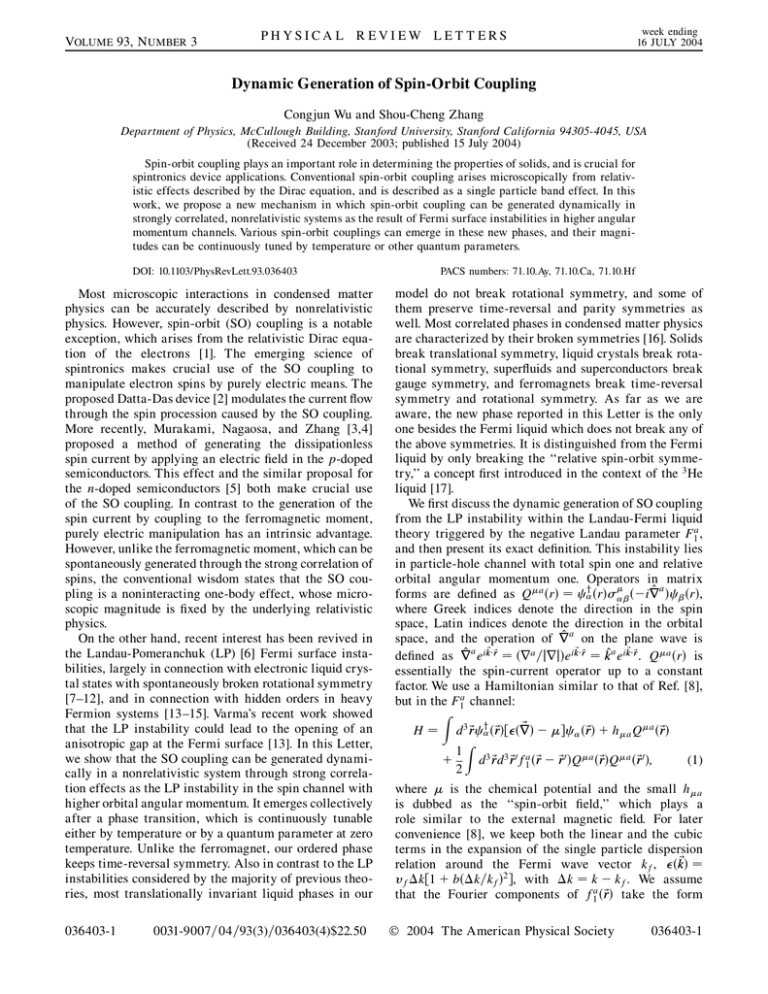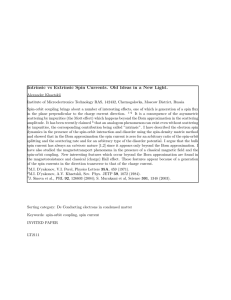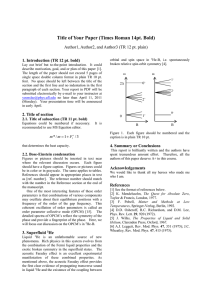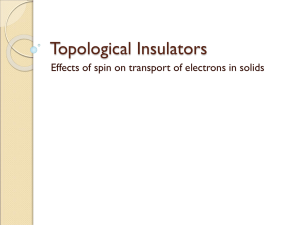Dynamic Generation of Spin-Orbit Coupling Congjun Wu and Shou-Cheng Zhang
advertisement

VOLUME 93, N UMBER 3 PHYSICA L R EVIEW LET T ERS week ending 16 JULY 2004 Dynamic Generation of Spin-Orbit Coupling Congjun Wu and Shou-Cheng Zhang Department of Physics, McCullough Building, Stanford University, Stanford California 94305-4045, USA (Received 24 December 2003; published 15 July 2004) Spin-orbit coupling plays an important role in determining the properties of solids, and is crucial for spintronics device applications. Conventional spin-orbit coupling arises microscopically from relativistic effects described by the Dirac equation, and is described as a single particle band effect. In this work, we propose a new mechanism in which spin-orbit coupling can be generated dynamically in strongly correlated, nonrelativistic systems as the result of Fermi surface instabilities in higher angular momentum channels. Various spin-orbit couplings can emerge in these new phases, and their magnitudes can be continuously tuned by temperature or other quantum parameters. DOI: 10.1103/PhysRevLett.93.036403 Most microscopic interactions in condensed matter physics can be accurately described by nonrelativistic physics. However, spin-orbit (SO) coupling is a notable exception, which arises from the relativistic Dirac equation of the electrons [1]. The emerging science of spintronics makes crucial use of the SO coupling to manipulate electron spins by purely electric means. The proposed Datta-Das device [2] modulates the current flow through the spin procession caused by the SO coupling. More recently, Murakami, Nagaosa, and Zhang [3,4] proposed a method of generating the dissipationless spin current by applying an electric field in the p-doped semiconductors. This effect and the similar proposal for the n-doped semiconductors [5] both make crucial use of the SO coupling. In contrast to the generation of the spin current by coupling to the ferromagnetic moment, purely electric manipulation has an intrinsic advantage. However, unlike the ferromagnetic moment, which can be spontaneously generated through the strong correlation of spins, the conventional wisdom states that the SO coupling is a noninteracting one-body effect, whose microscopic magnitude is fixed by the underlying relativistic physics. On the other hand, recent interest has been revived in the Landau-Pomeranchuk (LP) [6] Fermi surface instabilities, largely in connection with electronic liquid crystal states with spontaneously broken rotational symmetry [7–12], and in connection with hidden orders in heavy Fermion systems [13–15]. Varma’s recent work showed that the LP instability could lead to the opening of an anisotropic gap at the Fermi surface [13]. In this Letter, we show that the SO coupling can be generated dynamically in a nonrelativistic system through strong correlation effects as the LP instability in the spin channel with higher orbital angular momentum. It emerges collectively after a phase transition, which is continuously tunable either by temperature or by a quantum parameter at zero temperature. Unlike the ferromagnet, our ordered phase keeps time-reversal symmetry. Also in contrast to the LP instabilities considered by the majority of previous theories, most translationally invariant liquid phases in our 036403-1 0031-9007=04=93(3)=036403(4)$22.50 PACS numbers: 71.10.Ay, 71.10.Ca, 71.10.Hf model do not break rotational symmetry, and some of them preserve time-reversal and parity symmetries as well. Most correlated phases in condensed matter physics are characterized by their broken symmetries [16]. Solids break translational symmetry, liquid crystals break rotational symmetry, superfluids and superconductors break gauge symmetry, and ferromagnets break time-reversal symmetry and rotational symmetry. As far as we are aware, the new phase reported in this Letter is the only one besides the Fermi liquid which does not break any of the above symmetries. It is distinguished from the Fermi liquid by only breaking the ‘‘relative spin-orbit symmetry,’’ a concept first introduced in the context of the 3 He liquid [17]. We first discuss the dynamic generation of SO coupling from the LP instability within the Landau-Fermi liquid theory triggered by the negative Landau parameter F1a , and then present its exact definition. This instability lies in particle-hole channel with total spin one and relative orbital angular momentum one. Operators in matrix ^a forms are defined as Qa r y r ir r, where Greek indices denote the direction in the spin space, Latin indices denote the direction in the orbital ^ a on the plane wave is space, and the operation of r ^ a eik~r~ ra =jrjeik~r~ k^a eik~r~ . Qa r is defined as r essentially the spin-current operator up to a constant factor. We use a Hamiltonian similar to that of Ref. [8], but in the F1a channel: Z ~ ~r ha Qa ~r H d3 r~ y r~r 1Z 3 3 0 a (1) d r~d r~ f1 r~ r~0 Qa ~rQa ~r0 ; 2 where is the chemical potential and the small ha is dubbed as the ‘‘spin-orbit field,’’ which plays a role similar to the external magnetic field. For later convenience [8], we keep both the linear and the cubic terms in the expansion of the single particle dispersion relation around the Fermi wave vector kf , k~ vf k1 bk=kf 2 , with k k kf . We assume that the Fourier components of f1a ~r take the form 2004 The American Physical Society 036403-1 week ending PHYSICA L R EVIEW LET T ERS 16 JULY 2004 VOLUME 93, N UMBER 3 R and orbital space, respectively, Da is any SO(3) rotation f1a q dr~eiq~ r~ f1a r f1a =1 jf1a jq2 and define the dimensionless Landau parameter F1a Nf f1a , where Nf matrix, and n is a real number. In other words, the correlation functions of operators Qa acquire a long is the density of states at Fermi energy. The symmetry of the Hamiltonian (1) is a direct product SO3L SO3S range part in the ordered states in the orbital and spin channels. n 2 d^ e^ phase; We define the spin-orbit susceptibility as a;b hQa ~rQb r~0 i ! ab a 2 a (6) Da phase; jf1 j hQa i=hb in the limit hb ! 0, which is diagonal, i.e., a;b a b , in the normal Fermi liquid phase. The as j~r r~0 j ! 1. This correlation function gives the rigFermi liquid correction to is given by orous definition for the new phases, independent of the m 1 approximate Fermi liquid theory used here. ; (2) FL 0 m 1 F1a =3 The phase is a straightforward generalization of the nematic Fermi liquid [8] to the triplet channel as shown in with m =m the ratio between the effective and bare Fig. 1, where the spin and orbital degrees of freedom masses. The spin-orbital susceptibility is enhanced for remain decoupled, and the rotational symmetry is broken. F1a < 0 and divergent as the critical point F1a 3 is Taking a special case na n z az , the dispersion rereached. lations for spin up and down branches are 0A k1;2 In the mean-field (MF) analysis, the p-h channel triplet R k n cos1, respectively, where 1 is the angle order parameter is defined as na ~r dr~f1a r between k and z axis. The Fermi surfaces for the two r0 hQa r0 i, and the external spin-orbit field ha is spin components are distorted in an opposite way as a a set to zero. Using the uniform ansatz R 3 n y r ~n , kf1;2 1=kf x cos11 bx2 cos2 1 1=3x2 , with Eq. (1) is decoupled into HMF d r~ ~rr the dimensionless parameter x n =v k . The chemif f ^ a ~r Vna na =2jfa j, with V the na ir 1 cal potential is shifted to ensure the particle number space volume. The self-consistent equation for the order conservation as =vf kf x2 =3. The remaining parameters reads symmetry is SO2L SO2S with the Goldstone manifold S2L S2S . Two Goldstone modes are the oscillations of Z d3 k~ a the distorted Fermi surfaces, and the other two are the na jf1a j h y k k^ ki; (3) 2%3 oscillations of the spin directions. p a In the phase, the rotational symmetry is preserved which is valid when the interaction range r0 jf1 j is with the dynamic generation of spin-orbit coupling as much larger than the distance betweenp particles 1=kf ; i.e., shown in Fig. 1. For example, with the ansatz na a the dimensionless parameter & kf jf1 j 1. n a , the MF Hamiltonian is reduced to The phase structures can be determined from the X Ginzburg-Landau (GL) free energy, which is similar to y kk n ~ k^ k: (7) HMF 3 the triplet pairing order parameter in the He system k [17,18]. Under the independent SO(3) rotations in the orbital and spin spaces RL and RS , na transforms as The single particle states can be classified according a is even under na ! RL; n;b R1 . Furthermore, n to the eigenvalues 1 of the helicity operator ~ k^, S;ba the time-reversal but odd under the parity transformation. with dispersion relations 0B k1;2 k n . The With these symmetry requirements, the GL free energy Fermi surface distortions of two helicity bands are can be constructed up to the quartic order as Fn A trnT n B1 trnT n 2 B2 trnT n2 : Compared with the complex order parameter in the superfluid 3 He case, the reality of the na restricts the free energy to contain only two quartic terms. Explicitly, trnT n na na ,21 ,22 ,23 , and trnT n2 na nb na nb ,41 ,42 ,43 , where ,21;2;3 are eigenvalues of nT n. For B2 < 0 or B2 > 0, Eq. (4) favors the the structures of ,21 ; ,22 ; ,23 to be proportional to 1; 0; 0 or 1; 1; 1, respectively. We name them as or phases whose general order parameter matrix structures are given by n d^ e^ a phase; for B2 < 0; a n (5) n Da phase; for B2 > 0; where d^ and e^ are two arbitrary unit vectors in the spin 036403-2 δkf1 (4) δkf1 s δkf2 s k2 k1 δkf2 s s α−phase β−phase FIG. 1. The LP instability in the F1a channel, with dashed lines marking the Fermi surface before symmetry breaking. The Fermi surface distortion is anisotropic in the phase, while it is isotropic in the phase with dynamic generation of spin-orbit coupling. 036403-2 VOLUME 93, N UMBER 3 PHYSICA L R EVIEW LET T ERS kf1;2 =kf x1 bx2 x2 and the chemical potential shift =vf kf x2 . Similar to the superfluid 3 He-B phase, the phase is essentially isotropic. The orbital L~ and the spin S~ angular momenta are no longer separately conserved, but the total angular momentum J~ L~ S~ 0 remains conserved. The Goldstone manifold is SO3L SO3S =SO3LS SO3 with three branches of Goldstone modes. For the general case of na n Da , it is equivalent to a redefinition of spin operators as S0 S Da a , thus Fermi surface distortions remain isotropic and J~0 L~ S~0 is conserved. A similar symmetry breaking pattern also appears in the quantum chromodynamics where the two-flavor chiral symmetry SU2L SU2R is broken into the diagonal SU2LR [19]. In that case, both SU2L;R are internal symmetries, and thus there is no flavor-orbit coupling. The coefficients of the GL free energy Eq. (4) can be microscopically derived from the MF theory as Nf Nf 1 1 b A ; 1 ; B 1 2 jf1a j 3 3 20v2f k2f Nf 1 b ; (8) B2 30v2f k2f 3 where b describes the cubic part of the dispersion k, as explained earlier. With the definition of 1=jF1a j 1=3, the LP instability takes place at < 0, i.e., F1a < 3. For b < 1=3, i.e., B2 < 0, the phase appears with jn j2 jAj=2B1 B2 . For b > 1=3, i.e., B2 > 0, the phase is stabilized at with jn j2 jAj=23B1 B2 . The largest Fermi surface distortion kf;max =kf in the phase is larger than the uniform one kf =kf in the phase, thus a large positive b is helpful to the phase. However, we emphasize that this is only one of the options to change the sign of B2 . To apply the and phases in the lattice system, we only need replace the SO3L symmetry with the lattice point group. For example, for the simple cubic lattice, we define Qa ifcy x~ cx~ e^ a H:c:g with e^ a the base vector in the a direction. The unbroken symmetry is OL SO3S where OL is the orbit lattice octahedral group. The mean-field Hamiltonian for the phase reads X y sinka a k ; HMF (9) k k n k with lattice momentum k~ restricted in the first Brillouin zone. The helicity structure for each k~ is aligned along the direction of sinkx ; sinky ; sinkz , which breaks the symmetry down to the combined octahedral rotation in the orbit and spin space OLS . As a real space analogy, the hexagonal noncolinear antiferromagnet YMnO3 [20,21] has the spin order pattern inside the unit cell which is also invariant under the combined spin-orbit point group rotations. The difference is that the spin order in the phase lies in the momentum space and no spatial spin order exists at each lattice site. The lattice phase was origi036403-3 week ending 16 JULY 2004 nally studied under the name of ‘‘spin-split state’’ by Hirsch [22] to explain the phase transition at TN 311 K in the chromium system. By reducing the space dimension to 2, the mean-field Hamiltonian for the phase reduce to the familiar Rashba [23] and Dressselhaus Hamiltonians [24] in the 2D semiconductor heterostructures. The order parameter na is a 3 2 matrix with x; y; z and a x; y. Its third row of z can be transformed to zero by performing suitable SO(3) rotation on the index , thus we take na as a 2 2 matrix. The GL free energy is also the same as in Eq. (4), but with the new coefficients Nf Nf 1 1 A ; ; B1 a 2 jf1 j 2 32v2f k2f bNf B2 2 2 ; (10) 8vf kf and the LP instability occurs at F1a < 2. The - and -phase structures are similar as before in Eq. (5). However, there are two options in the phase with na n Da , where Da is a O2 matrix. If detD 1, then Jz Lz Sz is conserved. With the MF ansatz na n a , we arrive at the Rashba-like Hamiltonian Z ~ n za ir ^ a g : (11) HR d2 r~ y fr If detD 1, Jz is not conserved while the energy spectrum and Fermi surface distortions are still the same as the case of detD 1. With the MF ansatz na n diagf1; 1g, we arrive at the 2D Dresselhaus-like Hamiltonian as Z ~ n x ir ^ x y ir ^ y g : (12) HD d2 r~ y fr If we generalize the mechanism of dynamical generation of the spin-orbit coupling to the spin 3=2 Fermionic system, an interesting phase can be obtained which preserves all familiar symmetries including the parity symmetry, breaking only the relative spin-orbit symmetry. It has been recently shown that any generic model of spin 3=2 with local interactions has an exact SO5 symmetry in the spin space [25]. The four spin components form the spinor representation of the SO5 group. Using the Dirac # matrix defined there, the spin 3=2 Landau interaction functions are classified into the SO5’s scalar, vector, and tensor channels [25]: f;7 p~ ; p~ 0 fs p~ ; p~ 0 fv p~ ; p~ 0 #a =2 #a =27 ft p~ ; p~ 0 #ab =2 #ab =27 : (13) We further pick out its L 2 part of the orbital angular momentum in the spin two vector channel denoted as the F2v channel. We define operators Qa r~ y ~ ~r1 ; a 5, where d^a r ~ r~# d^a r p p p p 2 2 ^ xr ^ xr ^ yr ^z r ^ ; 3 r ^ 2x ^ y ; 3r ^ z ; 3r ^ z ; 1 3r 3r 2 2 036403-3 VOLUME 93, N UMBER 3 PHYSICA L R EVIEW LET T ERS ^ 2y . The model Hamiltonian is constructed as follows: r Z ~ r~ H d3 r~ y ~rr 1Z 3 3 0 v d r~d r~ f2 r~ r~0 Qa ~rQa ~r0 ; (14) 2 with the symmetry of SO3L SO5S . The order paR rameter is defined as before na r dr~3 f2v ~r r~0 hQa ~r0 i and the LP instability occurs when F2v Nf f2v q 0 < 5. The ordered phases after the LP instability can also be classified into two categories as before: the phase with anisotropic Fermi surface distortions and phase with spin-orbit coupling. The detail phase structures are much more complicated here. For example, the phase has two nonequivalent configurations because the L 2 channel Fermi surface distortions can be either uniaxial or biaxial. A comprehensive classification of all the possible phases is quite involved and is deferred to a future work. We focus here on the phase with the order parameter structure na n a . In this R case, the MF Hamiltonian is reduced into HMF d3 r~ y ~rfr ^ g r~. From the relation between the n a # da r # matrices and the quadratic form of spin 3=2 matrices S~ [4], it can be easily recognized the Luttinger-like Hamiltonian [26] Z ^ S~2 g r~; (15) HL d3 r~ y r~fr n ir which is the standard model for the hole-doped III-V semiconductors. The original symmetry SO3L SO5S in Eq. (14) is broken into SO3LS with ten branches of Goldstone modes. Different from the spin 1=2 case, the order parameter na here is even both under the time-reversal and parity transformations. It is remarkable that most standard spin-orbit systems, including the familiar Rashba, Dresselhaus, and Luttinger-like Hamiltonians can all be generated dynamically by our mechanism, which can compliment the conventional mechanism based on relativistic single particle physics. If a system has a small spin-orbit coupling to begin with, it acts like a spin-orbit field ha which rounds off the phase transition discussed here. One way to experimentally detect the dynamic generation of the spin-orbit coupling is through the anomalous Hall effect (AHE), which relies on the spin-orbit coupling. Therefore, detecting the AHE signal turning on at a phase transition directly demonstrates that the phase transition breaks the relative spin-orbit symmetry. We propose to systematically search for these new phases in 3 He, ultracold atomic systems, semiconductors, heavy Fermion materials, and ruthenates, both in experiments and in microscopic numerical simulations. The new phases can be experimentally detected through the standard predictions based on the spin-orbit coupling, but would have the remarkable and distinctive feature that these effects turn on and off near a phase transition. We 036403-4 week ending 16 JULY 2004 conjecture that besides the familiar superfluid A and B phases, 3 He may contain the new phases proposed in this work. The Landau parameter F1a in 3 He was determined to be negative from various experiments [27–30] such as the normal-state spin diffusion constant, spin-wave spectrum, and the temperature dependence of the specific heat, etc. It varies from around 0:5 to 1:2 with increasing pressures to the melting point, reasonably close to the instability point F1a 3. Even though we presented mean-field descriptions of the new phases with dynamically generated spin-orbit coupling, the existence of these phase can obviously be studied by exact microscopic calculations of the correlation function Eq. (6) for realistic models. We thank J. P. Hu and S. Kivelson for helpful discussions. C.W. especially thanks E. Fradkin and V. Oganesyan for their education on nematic Fermi liquids. This work is supported by the NSF under Grant No. DMR-0342832, and the U.S. Department of Energy, Office of Basic Energy Sciences under Contract No. DE-AC03-76SF00515. C.W. is supported by the Stanford SGF. [1] C. Kittel, Quantum Theory of Solids (Wiley Press, New York, 1987). [2] S. Datta and B. Das, Appl. Phys. Lett. 56, 665 (1990). [3] S. Murakami, N. Nagaosa, and S. C. Zhang, Science 301, 1348 (2003). [4] S. Murakami et al., cond-mat/0310005 [Phys. Rev. B (to be published)]. [5] J. Sinova et al., Phys. Rev. Lett. 92, 126603 (2004). [6] I. I. Pomeranchuk, Sov. Phys. JETP 8, 361 (1959). [7] C. J. Halboth et al. Phys. Rev. Lett. 85, 5162 (2000). [8] V. Oganesyan et al., Phys. Rev. B 64, 195109 (2001). [9] D. G. Barci et al. Phys. Rev. B 67, 205108 (2003). [10] W. Metzner et al., Phys. Rev. Lett. 91, 66402 (2003). [11] H. Y. Kee, Phys. Rev. B 67, 73105 (2003). [12] H. Y. Kee et al., Phys. Rev. B 68, 245109 (2003). [13] C. M. Varma, cond-mat/0311145 (unpublised). [14] T. T. M. Palstra et al., Phys. Rev. Lett. 55, 2727 (1985). [15] A. P. Ramirez et al., Phys. Rev. Lett. 68, 2680 (1992). [16] P.W. Anderson, Basic Notions of Condensed Matter Physics (Westview Press, Boulder, Colorado, 1997). [17] D. Vollhardt and P. Wolfle, The Superfluid Phases of Helium 3 (Taylor & Francis, London, New York, 1990). [18] A. J. Leggett, Rev. Mod. Phys. 47, 331 (1975). [19] F. Wilczek, Nucl. Phys. A642, 1C (1998). [20] A. F. Andreev et al., Sov. Phys. Usp. 23 (1980). [21] A. Munoz et al., Phys. Rev. B 62, 9498 (2000). [22] J. E. Hirsch, Phys. Rev. B 41, 6820 (1990). [23] E. I. Rashba, Sov. Phys. Solid State 2, 1109 (1960). [24] G. Dresselhaus, Phys. Rev. 100, 580 (1955). [25] C. J. Wu et al., Phys. Rev. Lett. 91, 186402 (2003). [26] J. M. Luttinger, Phys. Rev. 102, 1030 (1956). [27] A. J. Leggett, J. Phys. C 3, 448 (1970). [28] L. R. Corruccini et al., Phys. Rev. Lett. 27, 650 (1971). [29] D. D. Osheroff, Physica (Amsterdam) B&C90, 20 (1977). [30] D. S. Greywall, Phys. Rev. B 27, 2747 (1983). 036403-4






